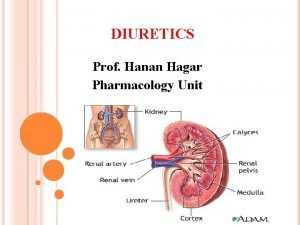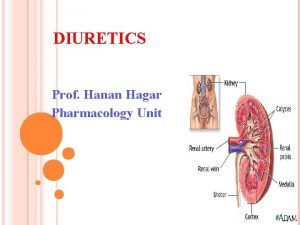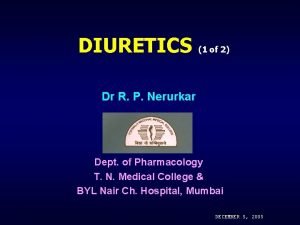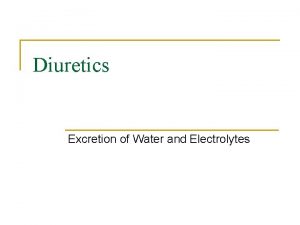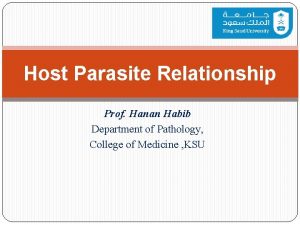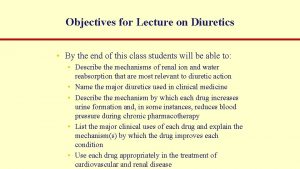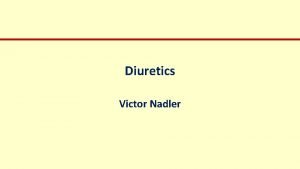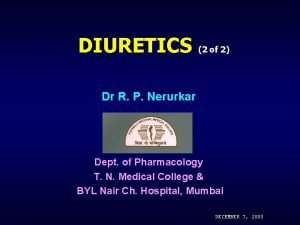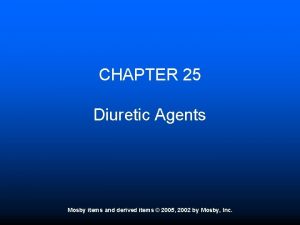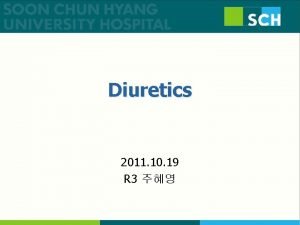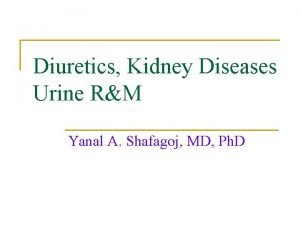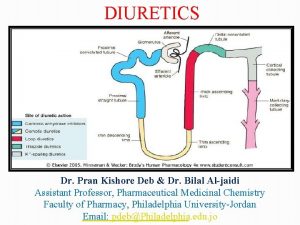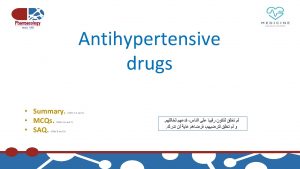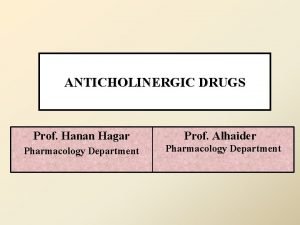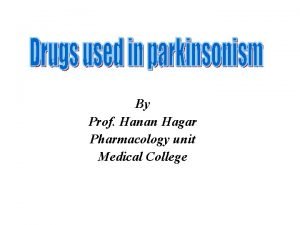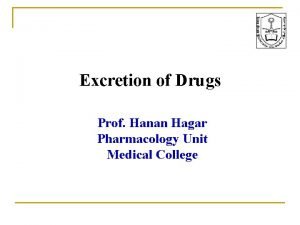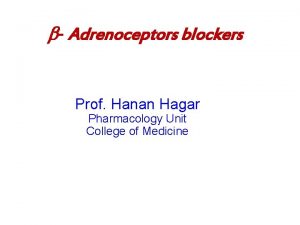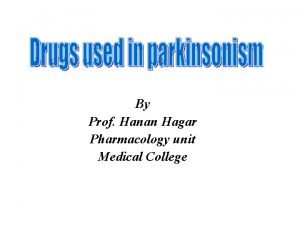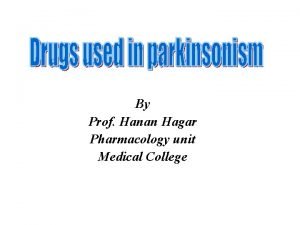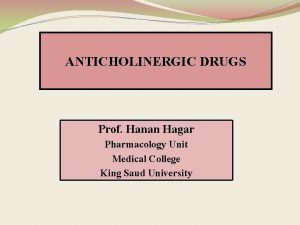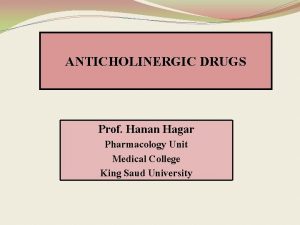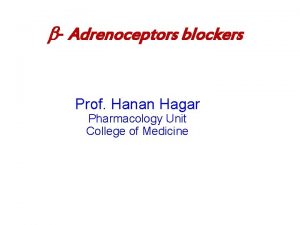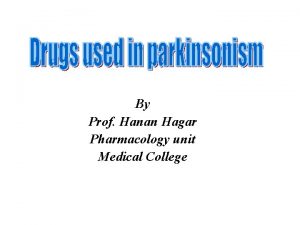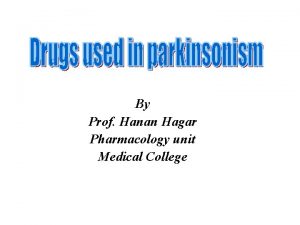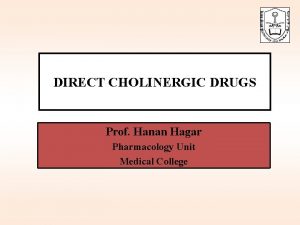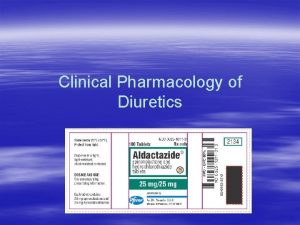DIURETICS Prof Hanan Hagar Pharmacology Unit CLASSIFICATION OF





























- Slides: 29

DIURETICS Prof. Hanan Hagar Pharmacology Unit

CLASSIFICATION OF DIURETICS Carbonic anhydrase inhibitors Loop diuretics Thiazide diuretics Potassium-sparing diuretics Osmotic diuretics

Potassiumsparing diuretics Spironolactone Amiloride Triamterene 5 %

Potassium-sparing diuretics Steroids Competitive aldosterone antagonists Spironolactone Eplerenone Nonsteroids Na+ channels inhibitors • Amiloride • Triamterene

Aldosterone Antagonists Also Called: • K-Sparing Diuretics • Mineralocorticoid receptor antagonists Spironolactone Eplerenone

Mechanism of action Spironolactone: act at the collecting duct by competitive inhibition of cytoplasmic aldosterone receptors Excretion of Na+, Cl- & Excretion of K+, H+

COLLECTED TUBULES (CT)

Pharmacokinetics of spironolactone o. Well absorbed from the GIT o Highly protein-bound o. Undergoes enterohepatic recycling o. Delayed onset of action (nuclear receptor), maximum diuretic action 4 days. o. Converted in the gut & liver to active metabolite, t½=16 h]

Pharmacodynamics: urinary Na+ excretion urinary K+ excretion Hyperkalemia H+ excretion (acidosis). has antiandrogenic action.

THERAPEUTIC USES: Treatment of hypertension Usually used combined with thiazide or loop diuretics to: Enhances natriuresis caused by other diuretics Correct for hypokalemia.

THERAPEUTIC USES OF ALDOSTERONE ANTAGONISTS: Treatment of primary hyperaldosteronism (Conn's syndrome) Treatment of secondary hyperaldosteronism in diseases as CHF Edema of hepatic cirrhosis Nephrotic syndrome

THERAPEUTIC USES OF ALDOSTERONE ANTAGONISTS: Treatment of hirsutism, acne due to the antiandrogenic effects.


ADVERSE EFFECTS Hyperkalaemia. Metabolic acidosis. Gynecomastia Impotence Menstrual irregularities GIT upset and peptic ulcer

CONTRAINDICATIONS: Hyperkalaemia: chronic renal failure K+ supplement use -blockers ACE inhibitors. Liver disease (dose adjustment is needed).

Drug -Drug Interactions ↑Hyperkalemiainduced by K-Sparing diuretics

Potassium-sparing diuretics Na+ channels inhibitors o. Amiloride o. Triamterene

Sodium channel inhibitors Triamterene Potency 0. 1, t½ 4. 2 h, Amiloride Potency 1, t½ 21 h,

Mechanism of action Inhibition of Na influx through direct blockade of the epithelial sodium channel (ENa. C) on the lumen side of the kidney collecting tubule (triamterene – amiloride).

Uses of Sodium channel inhibitors o. Used in Combination with Loop & Thiazide Diuretics o. Treatment for lithium-Induced Diabetes Insipidus

Adverse effects of Sodium channel inhibitors Triamterene Hyperkalemia Renal stones Amiloride Hyperkalemia

Contraindications of Sodium channel inhibitors Triamterene & amiloride The risk of developing hyperkalemia is increased in patients who are also on ACE inhibitors, angiotensin II receptor antagonists, other potassium-sparing diuretics, or any potassium-containing supplements.

THERAPEUTIC APPLICATIONS OF DIURETICS Treatment of hypertension: o Thiazide diuretics o used alone or in combination with betablockers at low-dose (fewer side effects) o In presence of renal failure, loop diuretic is used.

THERAPEUTIC APPLICATIONS OF DIURETICS Edema States o Thiazide diuretic is used in mild edema with normal renal function o Loop diuretics are used in cases with impaired renal function.

Congestive Heart failure Ø Thiazides may be used in only mild cases with well-preserved renal function Ø Loop diuretics are much preferred in severe cases especially when GF is lowered Ø In life-threatening acute pulmonary edema, furosemide is given IV.

Renal failure Ø Thiazides are used till GFR ≥ 40 -50 ml/min Ø Loop diuretic are used below given values, with increasing the dose as GFR goes down. Diabetes inspidus Large volume (>10 L/day) of dilute urine thiazide diuretics reduces urine volume Hepatic cirrhosis with ascites Ø Spironolactone is the drug of choice.

Diuretics CA inhibitors Acetohexamide Dorzolamide Osmotic diuretic Mannitol Loop diuretics Furosemide Thiazide diuretics hydrochlorothiazide K-sparing diuretic Spironolactone. Mechanism of action Effects Inhibition of Na. HCO 3 Urinary Na HCO 3, K reabsorption in PCT Urinary alkalosis Metabolic acidosis Osmotic effect in PCT U rine excretion Little Na Na/K/2 Cl transporter Urinary Na, K, Ca, Mg in TAL the most effective Na and Cl cotransporter in DCT rinary Na, K, Mg U BUT↓ urinary Ca (hypercalcemia) Metabolic alkalosis competitive antagonist ↑ Urinary Na of aldosterone in CCT ↓ K, H secretion Metabolic acidosis

Diuretics CA inhibitors Acetohexamide Dorzolamide (topically) for glaucoma Osmotic diuretic Mannitol Loop diuretics Furosemide Thiazide diuretics hydrochlorothiazide K-sparing diuretic Spironolactone. Uses Glaucoma, epilepsy Mountain sickness Alkalosis Phosphatemia • Cerebral edema, glaucoma • Acute renal failure, drug toxicities Acute pulmonary edema (Drug of choice) Heart failure Hyperkalemia, Hypercalcemia Commonly used Hypertension, mild heart failure, nephrolithiasis, diabetes inspidus Hepatic cirrhosis (Drug of choice)

Diuretics CA inhibitors Acetohexamide Dorzolamide Osmotic diuretic Mannitol Loop diuretics Furosemide Thiazide diuretics hydrochlorothiazide K-sparing diuretic Spironolactone. Side effects Metabolic acidosis , Urinary alkalosis Hypokalemia Extracellular water expansion Dehydration Hypernatremia Hypokalemia, hypovolemia, hyponatremia, hypomagnesemia, hypocalcemia Precipitate gout, alkalosis Hypokalemia, hyponatremia, hypovolemia, hypomagnesemia, hypercalcemia Alkalosis, precipitate gout Hyperlipidemia, hyperglycemia Gynaecomastia Hyperkalaemia, Metabolic acidosis. GIT upset and peptic ulcer
 Classification of diuretics
Classification of diuretics Diuretics classification
Diuretics classification Diuretics classification
Diuretics classification Diuretics classification
Diuretics classification Side effects of diuretics
Side effects of diuretics Diuretics classification
Diuretics classification Osmotic diuretics
Osmotic diuretics Hagar and ishmael
Hagar and ishmael Hagar hamed rua
Hagar hamed rua Enzyme inducer drugs
Enzyme inducer drugs Glucouronide
Glucouronide A tirinha de hagar estabelece uma interessante contraponto
A tirinha de hagar estabelece uma interessante contraponto Smith
Smith The stone angel chapter wise summary
The stone angel chapter wise summary Hanan lutfiyya
Hanan lutfiyya Tim vidas
Tim vidas Hanan habib
Hanan habib Primary tuberculosis
Primary tuberculosis Diuretics side effects
Diuretics side effects Loop diuretics adverse effects
Loop diuretics adverse effects Loop diuretics adverse effects
Loop diuretics adverse effects Acetazolamise
Acetazolamise Spironolactone uses
Spironolactone uses Potassium sparing diuretics mechanism of action
Potassium sparing diuretics mechanism of action Side effects of diuretics
Side effects of diuretics Chlorothalidon
Chlorothalidon Antidiuretic drugs
Antidiuretic drugs Urine r&m
Urine r&m Chlorothiazide synthesis
Chlorothiazide synthesis Pharmacology and venipuncture
Pharmacology and venipuncture

